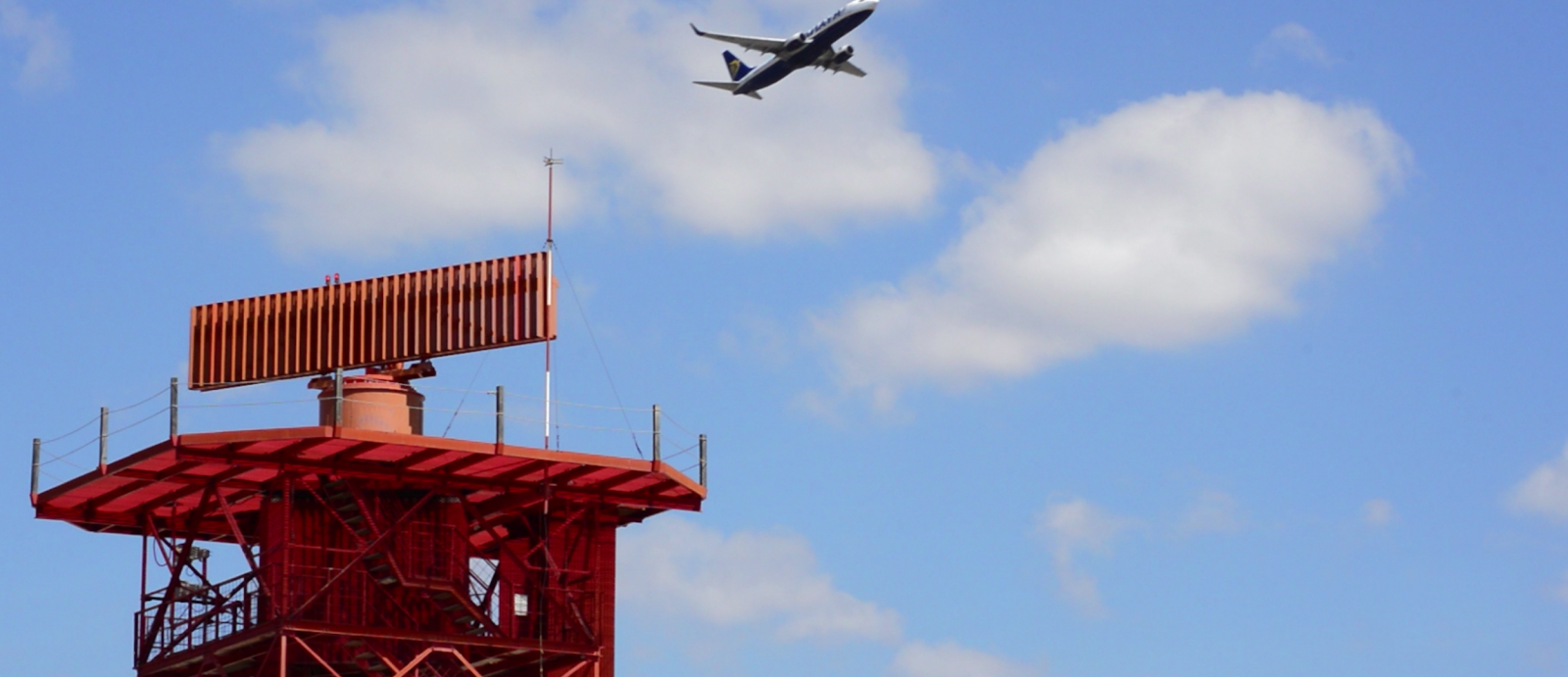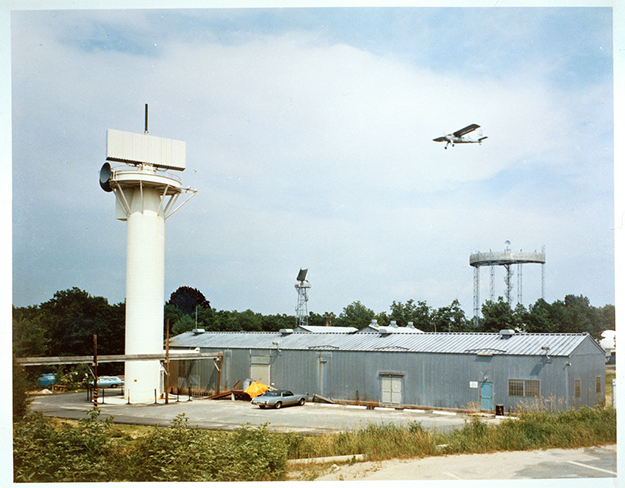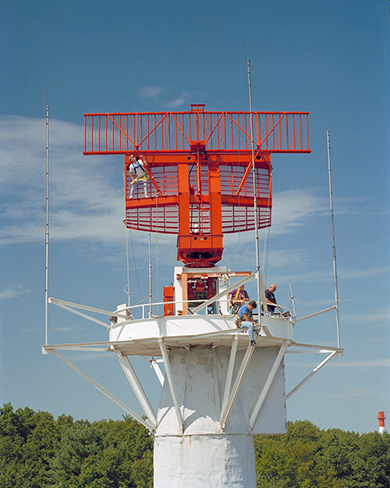
A global mode of tracking aircraft
Imagine you need to pick up a friend at the airport later today. To check the arrival time, you look the flight up on FlightAware. This popular flight-tracking website shows you precisely where on Earth your friend’s flight is. You can see the direction the aircraft is headed, its altitude, and its speed. All points indicate that the flight is right on time.
Access to such flight information is easy to take for granted today. But this ability to track flights in real time is only made possible by an aircraft surveillance system built upon technology first developed at Lincoln Laboratory. That foundational technology, called Mode S, established the communication protocols that allow an airplane to broadcast key flight data to any receiver in range, and forms the backbone of modern air traffic control (ATC) capabilities. An estimated 100,000 aircraft in the world are equipped with Mode S, and more than 900 Mode S radars are deployed across the globe.
“This technology touches everybody who flies, every time they fly, for the entire duration of their flight,” says Wesley Olson, a group leader in the Laboratory’s Homeland Protection and Air Traffic Control Division, where Mode S was first envisioned. “If it wasn't for Mode S, we would have a very different air transportation system today, one that would be far less efficient and far less safe.”

The arrival of a new system
The role of ATC is to monitor and maintain the separation of aircraft. Radar allows air traffic controllers to do so. Until the 1950s, they had only primary radar, which sends out a signal that bounces off an airplane and then returns to the radar antenna. This signal can tell controllers that an airplane is up in the sky, but can't directly identify which plane it is or how high it is. To improve ATC capabilities, a secondary type of radar system was invented. This system, called the ATC radar beacon system (ATCRBS), communicates with a transponder affixed to an aircraft. As a radar transmits a signal skyward, any transponder in range picks this signal up and sends a message back to controllers identifying its aircraft and altitude.

In the 1960s, as air traffic grew and the skies became more congested, a new problem emerged: the ATCRBS channels were receiving flocks of replies simultaneously, and these replies were interfering with each other. The garbled signals couldn't be pulled apart from one another, and, as a result, planes could go undetected. An ATC committee assembled by Lincoln Laboratory predicted that the channels would grow more saturated and even become inoperable.
To address this overlap issue, Lincoln Laboratory put forth the Mode S radar beacon system. The "S" stands for select — the system allows radars to selectively interrogate aircraft, as opposed to sending out a general signal to which all aircraft in range respond. Each aircraft transponder is assigned a unique address code. Using this unique code, radars can systematically direct interrogations to a particular aircraft, and replies can be unambiguously identified, even those received from closely spaced aircraft.
Besides its ability to select which aircraft to communicate with, Mode S introduced technical improvements that increased the quality and types of information ATC receives. New methods of signal processing could determine the position of an airplane much more accurately and with less radar interrogations than needed with the older ATCRBS system. The return message from a Mode S transponder now included much more technical data than just a plane's identity and altitude; it revealed the plane's heading, roll angle, and airspeed, providing a clearer picture of air traffic.
An international standard takes off
From 1969 to 1979, Lincoln Laboratory developed, tested, and verified the technical approach underlying the Mode S beacon radar system, under sponsorship of the Federal Aviation Administration (FAA). An experimental radar facility was set up at the Laboratory, and airplanes at the Laboratory's Flight Test Facility were used to validate transponder prototypes.
The FAA's key concern with the design of Mode S was compatibility. Because many operating aircraft would still be equipped with the original ATCRBS transponders, signals from the Mode S system could not interfere with the legacy system. The Laboratory's plan addressed this concern by designing the new beacon system not only to be compatible with the old system but also to employ the same antennas and operate in the same frequency band. These characteristics meant that radars on the ground did not have to be extensively changed, and that these radars could still receive replies both from old ATCRBS transponders and new Mode S transponders.

Once the Mode S system concept was proven out, its developers at the Laboratory served as the FAA's principal technical agents in generating standards for Mode S, documenting its operation and design. Following approval of these standards by the FAA and U.S. government, industry partners manufactured Mode S transponders for airlines. The Laboratory also worked closely with the International Civil Aviation Organization (ICAO) to ensure Mode S standards would be accepted by aviation organizations globally.
By the mid-1990s, the FAA required Mode S transponders to be installed on most U.S. registered aircraft, and, later, the ICAO adopted Mode S as a worldwide standard. By 2009, Mode S was required for flights in the airspace over much of Europe.
The Laboratory continues to partner with the ICAO on supporting and updating the implementation of Mode S around the world, including in Asia, the South Pacific, Africa, and the Middle East. Today, Mode S is considered the backbone of the world's air transportation system infrastructure.
Technology on the horizon
Beyond improving the ability of ATC to direct air traffic, Mode S introduced another core safety system: airborne collision avoidance. While initially designed to reply to signals from ground radar, Mode S technology gave aircraft the ability to transmit signals themselves, thus functioning as an airborne radar. With this two-way function, airplanes could interrogate each other and track each other, independent of ATC on the ground. This air-to-air tracking capability became the foundation for the Traffic Alert and Collision Avoidance System (TCAS), another standardized system that automatically alerts pilots of midair collision threats.
Today, Mode S and its datalink continue to enable the next generation of aircraft surveillance. The FAA’s most recently mandated ATC system, Automatic Dependent Surveillance – Broadcast (ADS-B), no longer requires the use of ground radar to track aircraft at all, thanks in part to the foundation provided by Mode S. Like with TCAS, aircraft can use their Mode S transponder to continuously broadcast their position and flight data to any antenna able to receive it, whether the antenna is on the ground, in the air, or even in space. For the first time, satellites are being used to track aircraft in real time over areas that have traditionally been outside of radar range, such as over oceans.
More than 50 years have passed since Lincoln Laboratory first devised Mode S as a better approach to ATC. The innovative, fundamental ideas that led to Mode S cemented the Laboratory’s Air Traffic Control enterprise as a trusted visionary for the FAA and continue to inform the development of air traffic infrastructure today.